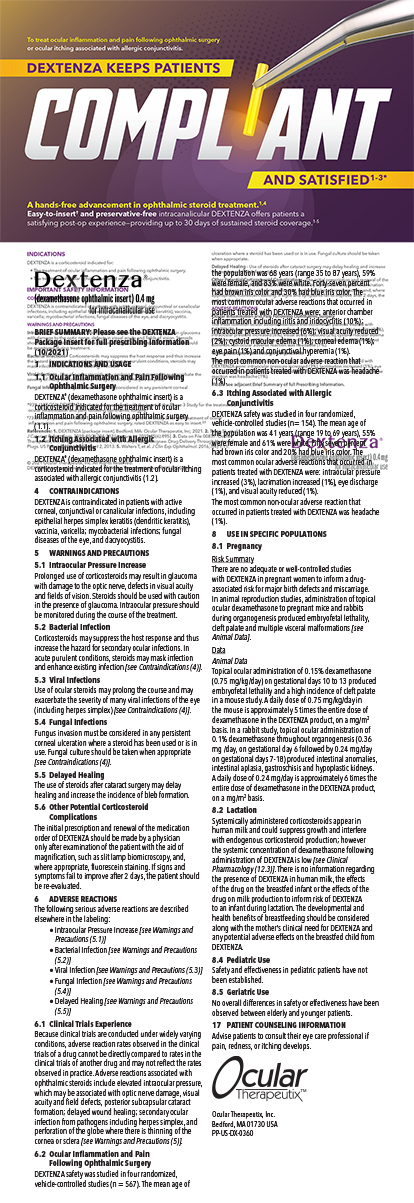Buttonhole flaps can normally prove problematic when attempting to retreat a patient for regression. However, when a patient has had a buttonhole followed by two keratectomies, treating subsequent regression becomes downright tricky. This article offers some practical insights on how to handle a cornea that's been through so much.
Option 1: PTK/PRK
When retreating an eye that has had a buttonhole flap and two keratectomies, the surgeon's first treatment option is to perform a procedure such as PTK/PRK using mitomycin C (MMC). The advantage of this approach is that applying the laser on top of the flap removes any scar from the buttonhole that may cause visual distortions and a loss of best-corrected visual acuity (BCVA). However, ablating the corneal surface after two previous keratectomies can greatly increase the risk of haze, and predicting the refractive outcome will be more difficult.
I have been generally concerned that PTK and PRK exhibit a significant risk of producing haze. MMC may be successful in reducing that risk, but we will have to wait and see whether long-term haze still presents 1 or 2 years following these types of treatments. The MMC treatments that I have performed have not resulted in haze after a year, but additional follow-up is necessary.
Option 2: LASIK Enhancement
The second treatment option in such a case is to perform a LASIK enhancement. If the surgeon is able to lift the flap successfully, he or she will achieve a very predictable outcome, and will also avoid the risk of haze. The disadvantage of using this method is that relifting the buttonhole flap after two keratectomies carries a risk of flap fragmentation, either along the edges of the two flaps, or in the center around the buttonhole. In addition, relifting the flap will not improve visual distortions caused by the buttonhole.
Other considerations
Additional treatment options could include a third keratectomy, but my concern is that three lamellar cuts to the cornea would probably cause significant corneal attenuation, and enhance the risk of future ectasia. In addition, even cutting the cornea twice can result in a free wedge of tissue, and a third cut would carry an extremely high risk. Another option would be to perform RK cuts to reduce any slight myopia. Once again, however, performing radial cuts on top of two lamellar cuts will overly weaken the cornea. It would amount to slicing and dicing the cornea too many times, and my experience with radial cuts after lamellar surgery has poor predictability.
An Example
A case was referred to me in which the original, referring surgeon induced a buttonhole flap with the Automated Corneal Shaper™ (Bausch & Lomb Surgical, Inc., Claremont, CA) that occurred approximately 1 year prior to the patient's referral. The original refraction of the patient was -6 sphere. A laser was not applied after the buttonhole occurred. The flap had been nicely replaced, and the patient returned 7 months later for a LASIK enhancement. At that time, the patient's prescription had changed just slightly to -6.00 -0.50 X 90. The surgeon repeated the LASIK procedure, but used the Hansatome™ microkeratome (Bausch & Lomb Surgical, Inc.) with the 180 plate (the original procedure was performed with the Automated Corneal Shaper™ with the 160 plate). The initial effect was satisfactory and the patient was happy, however, her vision began to regress a few months postoperatively. Five months after the second keratectomy, the patient's prescription was -1.00 -0.50 X 86, and her BCVA was 20/20. She still noticed slight distortions in her vision from the original buttonhole flap.
I discussed the treatment options with the patient at great length. I did not want to perform RK because I consider it a less-established procedure after LASIK. I also ruled out a third keratectomy as it would cause undue attenuation on the cornea. The decision came between a surface ablation with MMC to prevent haze from forming, or relifting the flap. The patient and I weighed the risks of both approaches, and elected to try relifting the flap and attempting another LASIK enhancement.
Proceeding
Relifting the flap proved quite difficult. Once I lifted the edge and pulled the Hansatome™ flap back to where the edge from the second keratectomy was, there was 360&Mac251; of adhesion 1 mm to 2 mm in from the edge, except for where the hinge was located. I had to be very careful to dissect along the edge so that I did not tear the flap along that rim. Once I passed the rim of adhesion and advanced toward the center of the flap, I found that the entire area of the buttonhole was attached with fibrous attachments. I carefully dissected around the buttonhole to break it apart. Whereas a normal LASIK enhancement may require 10 or 15 seconds to lift the flap, this case necessitated 10 to 15 minutes. However, I was able to lift it successfully without any tearing or fragmentation. I performed the laser enhancement and replaced the flap.
Outcome
One month postoperatively, the patient's uncorrected vision was 20/30, BCVA was 20/25, and her prescription was -0.50 -0.50 X 90. The patient stated that there was still some slight distortion in her vision, but she was still very happy with her outcome. Six months postoperatively, her uncorrected vision was 20/25, her BCVA was 20/20, and her prescription was plano -0.50 X 90. The patient still experienced slight distortion, similar to what she had experienced with glasses over the buttonhole, but she was pleased with her outcome, so it turned out quite well.


